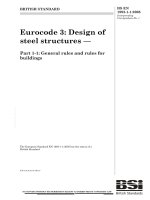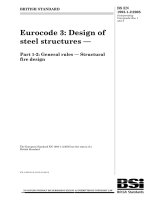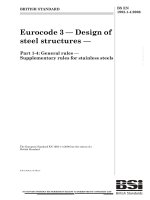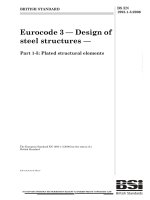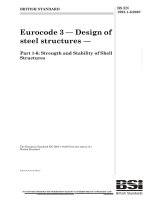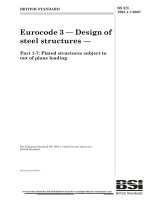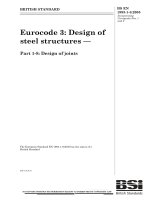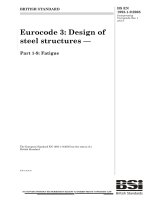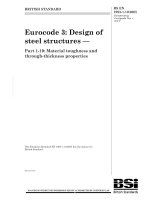Tiêu chuẩn Châu Âu EC3: Kết cấu thép phần 5: Cừ thép (Eurocode3 BS EN1993 5 e 2007 Design of steel structures part 5: Piling)
Bạn đang xem bản rút gọn của tài liệu. Xem và tải ngay bản đầy đủ của tài liệu tại đây (1.72 MB, 98 trang )
BRITISH STANDARD
BS EN
1993-5:2007
Incorporating
corrigendum
May 2009
Part 5: Piling
ICS 91.010.30; 91.080.10
12 &23<,1* :,7+287 %6, 3(50,66,21 (;&(37 $6 3(50,77(' %< &23<5,*+7 /$:
--`,`````,````,`,,`,,,``,,,``,-`-`,,`,,`,`,,`---
Eurocode 3 —
Design of steel
structures —
BS EN 1993-5:2007
National foreword
This British Standard is the UK implementation of EN 1993-5:2007,
incorporating corrigendum May 2009. It partially supersedes BS 449-2:1969
and BS 5950-1:2000, which will be withdrawn by March 2010.
The start and finish of text introduced or altered by corrigendum is indicated
in the text by tags. Text altered by CEN corrigendum May 2009 is indicated
in the text by ˆ‰.
The structural Eurocodes are divided into packages by grouping Eurocodes
for each of the main materials: concrete, steel, composite concrete and steel,
timber, masonry and aluminium; this is to enable a common date of
withdrawal (DOW) for all the relevant parts that are needed for a particular
design. The conflicting national standards will be withdrawn at the end of
the coexistence period, after all the EN Eurocodes of a package are available.
Following publication of the EN, there is a period allowed for national
calibration during which the National Annex is issued, followed by a
coexistence period of a maximum 3 years. During the coexistence period
Member States are encouraged to adapt their national provisions. Conflicting
national standards will be withdrawn by March 2010 at the latest.
The UK participation in its preparation was entrusted by Technical
Committee B/525, Building and civil engineering structures, to Subcommittee
B/525/31.
A list of organizations represented on this subcommittee can be obtained on
request to its secretary.
Where a normative part of this EN allows for a choice to be made at the
national level, the range and possible choice will be given in the normative
text, and a note will qualify it as a Nationally Determined Parameter (NDP).
NDPs can be a specific value for a factor, a specific level or class, a particular
method or a particular application rule if several are proposed in the EN.
To enable EN 1993-5 to be used in the UK, the NDPs will be published in a
National Annex, which will be made available by BSI in due course, after
public consultation has taken place.
This publication does not purport to include all the necessary provisions of a
contract. Users are responsible for its correct application.
Compliance with a British Standard cannot confer immunity from
legal obligations.
This British Standard was
published under the authority
of the Standards Policy and
Strategy Committee on
30 April 2007
Amendments/corrigenda issued since publication
Date
Comments
31 August 2009
Implementation of CEN corrigendum May 2009
© BSI 2009
ISBN 978 0 580 66477 9
--`,`````,````,`,,`,,,``,,,``,-`-`,,`,,`,`,,`---
EN 1993-5
EUROPEAN STANDARD
NORME EUROPÉENNE
EUROPÄISCHE NORM
February 2007
ICS 91.010.30; 91.080.10
Supersedes ENV 1993-5:1998
Incorporating corrigendum May 2009
English Version
Eurocode 3 - Design of steel structures - Part 5: Piling
Eurocode 3 - Calcul des structures en acier - Partie 5:
Pieux et palplanches
Eurocode 3 - Bemessung und Konstruktion von
Stahlbauten - Teil 5: Pfähle und Spundwände
This European Standard was approved by CEN on 12 June 2006.
CEN members are bound to comply with the CEN/CENELEC Internal Regulations which stipulate the conditions for giving this European
Standard the status of a national standard without any alteration. Up-to-date lists and bibliographical references concerning such national
standards may be obtained on application to the CEN Management Centre or to any CEN member.
This European Standard exists in three official versions (English, French, German). A version in any other language made by translation
under the responsibility of a CEN member into its own language and notified to the CEN Management Centre has the same status as the
official versions.
CEN members are the national standards bodies of Austria, Belgium, Bulgaria, Cyprus, Czech Republic, Denmark, Estonia, Finland,
France, Germany, Greece, Hungary, Iceland, Ireland, Italy, Latvia, Lithuania, Luxembourg, Malta, Netherlands, Norway, Poland, Portugal,
Romania, Slovakia, Slovenia, Spain, Sweden, Switzerland and United Kingdom.
EUROPEAN COMMITTEE FOR STANDARDIZATION
COMITÉ EUROPÉEN DE NORMALISATION
EUROPÄISCHES KOMITEE FÜR NORMUNG
Management Centre: rue de Stassart, 36
© 2007 CEN
B-1050 Brussels
All rights of exploitation in any form and by any means reserved
worldwide for CEN national Members.
--`,`````,````,`,,`,,,``,,,``,-`-`,,`,,`,`,,`---
Ref. No. EN 1993-5:2007: E
BS EN 1993-5:2007
EN 1993-5:2007 (E)
Contents
Page
Foreword .......................................................................................................................................................... 4
1
General ..................................................................................................................................................... 7
2
--`,`````,````,`,,`,,,``,,,``,-`-`,,`,,`,`,,`---
1.1
1.2
1.3
1.4
1.5
1.6
1.7
1.8
1.9
Basis of design ........................................................................................................................................ 20
2.1
2.2
2.3
2.4
2.5
2.6
2.7
3
Basis ................................................................................................................................................ 52
Displacements of retaining walls..................................................................................................... 52
Displacements of bearing piles........................................................................................................ 52
Structural aspects of steel sheet piling............................................................................................. 52
Anchors, walings, bracing and connections ........................................................................................ 54
7.1
2
Basis ................................................................................................................................................ 32
Sheet piling...................................................................................................................................... 32
Bearing piles.................................................................................................................................... 46
High modulus walls......................................................................................................................... 48
Combined walls ............................................................................................................................... 49
Serviceability limit states ...................................................................................................................... 52
6.1
6.2
6.3
6.4
7
General ............................................................................................................................................ 28
Durability requirements for bearing piles........................................................................................ 29
Durability requirements for sheet piling.......................................................................................... 30
Corrosion rates for design................................................................................................................ 30
Ultimate limit states............................................................................................................................... 32
5.1
5.2
5.3
5.4
5.5
6
General ............................................................................................................................................ 25
Bearing piles.................................................................................................................................... 25
Hot rolled steel sheet piles............................................................................................................... 25
Cold formed steel sheet piles........................................................................................................... 25
Sections used for waling and bracing .............................................................................................. 26
Connecting devices.......................................................................................................................... 26
Steel members used for anchors ...................................................................................................... 26
Steel members used for combined walls ......................................................................................... 26
Fracture toughness........................................................................................................................... 27
Durability ............................................................................................................................................... 28
4.1
4.2
4.3
4.4
5
General ............................................................................................................................................ 20
Ultimate limit state criteria .............................................................................................................. 20
Serviceability limit state criteria...................................................................................................... 21
Site investigation and soil parameters ............................................................................................. 21
Analysis ........................................................................................................................................... 22
Design assisted by testing................................................................................................................ 23
Driveability...................................................................................................................................... 24
Material properties................................................................................................................................ 25
3.1
3.2
3.3
3.4
3.5
3.6
3.7
3.8
3.9
4
Scope ................................................................................................................................................. 7
Normative references......................................................................................................................... 8
Assumptions ...................................................................................................................................... 8
Distinction between principles and application rules ........................................................................ 9
Definitions ......................................................................................................................................... 9
Symbols ............................................................................................................................................. 9
Units ................................................................................................................................................ 10
Terminology .................................................................................................................................... 11
Convention for sheet pile axes......................................................................................................... 19
General ............................................................................................................................................ 54
BS EN 1993-5:2007
EN 1993-5:2007 (E)
7.2
7.3
7.4
8
Execution ................................................................................................................................................ 64
8.1
8.2
8.3
8.4
8.5
A
B
General ............................................................................................................................................ 65
Basis of design................................................................................................................................. 66
Properties of materials and cross-sections....................................................................................... 66
Local buckling ................................................................................................................................. 70
Resistance of cross-sections ............................................................................................................ 72
Design by calculation ...................................................................................................................... 76
Design assisted by testing................................................................................................................ 77
[informative] - Testing of thin walled steel sheet piles ....................................................................... 79
--`,`````,````,`,,`,,,``,,,``,-`-`,,`,,`,`,,`---
B.1
B.2
B.3
B.4
B.5
General ............................................................................................................................................ 79
Single span beam test ...................................................................................................................... 79
Intermediate support test ................................................................................................................. 80
Double span beam test..................................................................................................................... 81
Evaluation of test results.................................................................................................................. 82
[informative] - Guidance for the design of steel sheet piling ............................................................. 84
C.1
C.2
D
General ............................................................................................................................................ 64
Steel sheet piling.............................................................................................................................. 64
Bearing piles.................................................................................................................................... 64
Anchorages ...................................................................................................................................... 64
Walings, bracings and connections ................................................................................................. 64
[normative] - Thin walled steel sheet piling ........................................................................................ 65
A.1
A.2
A.3
A.4
A.5
A.6
A.7
C
Anchorages ...................................................................................................................................... 54
Walings and bracing ........................................................................................................................ 56
Connections ..................................................................................................................................... 56
Design of sheet pile cross section at ultimate limit state ................................................................. 84
Serviceability limit state .................................................................................................................. 87
[informative] - Primary elements of combined walls ......................................................................... 89
D.1
D.2
I-sections used as primary elements ................................................................................................ 89
Tubular piles used as primary elements........................................................................................... 91
3
BS EN 1993-5:2007
EN 1993-5:2007 (E)
Foreword
This European Standard EN 1993-5, “Eurocode 3: Design of steel structures: Part 5 Piling”, has been
prepared by Technical Committee CEN/TC250 « Structural Eurocodes », the Secretariat of which is held by
BSI. CEN/TC250 is responsible for all Structural Eurocodes.
This European Standard shall be given the status of a National Standard, either by publication of an identical
text or by endorsement, at the latest by August 2007, and conflicting National Standards shall be withdrawn at
latest by March 2010.
This Eurocode supersedes ENV 1993-5:1998.
According to the CEN-CENELEC Internal Regulations, the National Standard Organizations of the
following countries are bound to implement this European Standard: Austria, Belgium, Bulgaria, Cyprus, Czech
Republic, Denmark, Estonia, Finland, France, Germany, Greece, Hungary, Iceland, Ireland, Italy, Latvia,
Lithuania, Luxembourg, Malta, Netherlands, Norway, Poland, Portugal, Romania, Slovakia, Slovenia, Spain,
Sweden, Switzerland and United Kingdom..
Background to the Eurocode programme
In 1975, the Commission of the European Community decided on an action programme in the field of
construction, based on article 95 of the Treaty. The objective of the programme was the elimination of
technical obstacles to trade and the harmonisation of technical specifications.
Within this action programme, the Commission took the initiative to establish a set of harmonised technical
rules for the design of construction works which, in a first stage, would serve as an alternative to the national
rules in force in the Member States and, ultimately, would replace them.
For fifteen years, the Commission, with the help of a Steering Committee with Representatives of Member
States, conducted the development of the Eurocodes programme, which led to the first generation of
European codes in the 1980’s.
In 1989, the Commission and the Member States of the EU and EFTA decided, on the basis of an agreement1
between the Commission and CEN, to transfer the preparation and the publication of the Eurocodes to the
CEN through a series of Mandates, in order to provide them with a future status of European Standard (EN).
This links de facto the Eurocodes with the provisions of all the Council's Directives and/or Commission’s
Decisions dealing with European standards (e.g. the Council Directive 89/106/EEC on construction products
- CPD - and Council Directives 93/37/EEC, 92/50/EEC and 89/440/EEC on public works and services and
equivalent EFTA Directives initiated in pursuit of setting up the internal market).
The Structural Eurocode programme comprises the following standards generally consisting of a number of
Parts:
EN 1990
EN 1991
EN 1992
EN 1993
EN 1994
EN 1995
EN 1996
EN 1997
EN 1998
EN 1999
Eurocode: Basis of structural design
Eurocode 1: Actions on structures
Eurocode 2: Design of concrete structures
Eurocode 3: Design of steel structures
Eurocode 4: Design of composite steel and concrete structures
Eurocode 5: Design of timber structures
Eurocode 6: Design of masonry structures
Eurocode 7: Geotechnical design
Eurocode 8: Design of structures for earthquake resistance
Eurocode 9: Design of aluminium structures
1 Agreement between the Commission of the European Communities and the European Committee for Standardisation (CEN)
concerning the work on EUROCODES for the design of building and civil engineering works (BC/CEN/03/89).
--`,`````,````,`,,`,,,``,,,``,-`-`,,`,,`,`,,`---
4
BS EN 1993-5:2007
EN 1993-5:2007 (E)
Eurocode standards recognise the responsibility of regulatory authorities in each Member State and have
safeguarded their right to determine values related to regulatory safety matters at national level where these
continue to vary from State to State.
Status and field of application of Eurocodes
The Member States of the EU and EFTA recognise that Eurocodes serve as reference documents for the
following purposes:
-
as a means to prove compliance of building and civil engineering works with the essential
requirements of Council Directive 89/106/EEC, particularly Essential Requirement Nº1 – Mechanical
resistance and stability - and Essential Requirement Nº2 - Safety in case of fire;
as a basis for specifying contracts for construction works and related engineering services;
as a framework for drawing up harmonised technical specifications for construction products (ENs and
ETAs)
The Eurocodes, as far as they concern the construction works themselves, have a direct relationship with the
Interpretative Documents2 referred to in Article 12 of the CPD, although they are of a different nature from
harmonised product standard3. Therefore, technical aspects arising from the Eurocodes work need to be
adequately considered by CEN Technical Committees and/or EOTA Working Groups working on product
standards with a view to achieving a full compatibility of these technical specifications with the Eurocodes.
The Eurocode standards provide common structural design rules for everyday use for the design of whole
structures and component products of both a traditional and an innovative nature. Unusual forms of
construction or design conditions are not specifically covered and additional expert consideration will be
required by the designer in such cases.
National Standards implementing Eurocodes
The National Standards implementing Eurocodes will comprise the full text of the Eurocode (including any
annexes), as published by CEN, which may be preceded by a National title page and National foreword, and
may be followed by a National Annex (informative).
The National Annex (informative) may only contain information on those parameters which are left open in
the Eurocode for national choice, known as Nationally Determined Parameters, to be used for the design of
buildings and civil engineering works to be constructed in the country concerned, i.e.:
-
values for partial factors and/or classes where alternatives are given in the Eurocode,
values to be used where a symbol only is given in the Eurocode,
geographical and climatic data specific to the Member State, e.g. snow map,
the procedure to be used where alternative procedures are given in the Eurocode,
references to non-contradictory complementary information to assist the user to apply the
Eurocode.
2
According to Art. 3.3 of the CPD, the essential requirements (ERs) shall be given concrete form in interpretative documents
for the creation of the necessary links between the essential requirements and the mandates for hENs and ETAGs/ETAs.
3
According to Art. 12 of the CPD the interpretative documents shall:
(a)
give concrete form to the essential requirements by harmonising the terminology and the technical bases and
indicating classes or levels for each requirement where necessary;
(b)
indicate methods of correlating these classes or levels of requirement with the technical specifications, e.g. methods
of calculation and of proof, technical rules for project design, etc.;
(c)
serve as a reference for the establishment of harmonised standards and guidelines for European technical approvals.
The Eurocodes, de facto, play a similar role in the field of the ER 1 and a part of ER 2.
5
--`,`````,````,`,,`,,,``,,,``,-`-`,,`,,`,`,,`---
-
BS EN 1993-5:2007
EN 1993-5:2007 (E)
Links between Eurocodes and product harmonised technical specifications (ENs and ETAs)
There is a need for consistency between the harmonised technical specifications for construction products
and the technical rules for works4. Furthermore, all the information accompanying the CE Marking of the
construction products which refer to Eurocodes should clearly mention which Nationally Determined
Parameters have been taken into account.
Additional information specific to EN 1993-5
EN 1993-5 gives design rules for steel sheet piling and bearing piles to supplement the generic rules in
EN 1993-1.
EN 1993-5 is intended to be used with Eurocodes EN 1990 - Basis of design, EN 1991 - Actions on
structures and Part 1 of EN 1997 Geotechnical Design.
Matters that are already covered in those documents are not repeated.
EN 1993-5 is intended for use by
-
committees drafting design related product, testing and execution standards,
clients (e.g. for the formulation of their specific requirements)
designers and constructors
relevant authorities.
Numerical values for partial factors and other parameters are recommended as basic values that provide an
acceptable level of safety. They have been selected assuming that an appropriate level of workmanship and
quality management applies.
Annex A and Annex B have been prepared to complement the provisions of EN 1993-1-3 for class 4 steel
sheet piles.
Annex C gives guidance on the plastic design of steel sheet pile retaining structures.
Annex D gives one possible set of design rules for primary elements of combined walls.
Reference should be made to EN 1997 for geotechnical design which is not covered in this document.
National Annex for EN 1993-5
This standard gives alternative procedures, values and recommendations for classes with notes indicating
where national choices may have to be made. Therefore the National Standard implementing EN 1993-5
should have a National Annex containing all Nationally Determined Parameters to be used for the design of
buildings and civil engineering works to be constructed in the relevant country.
National choice is allowed in EN 1993-5 through clauses:
3.7 (1)
3.9 (1)P
4.4 (1)
5.1.1 (4)
5.2.2 (2)
4
6
5.2.2 (13)
5.2.5 (7)
5.5.4 (2)
6.4 (3)
7.1 (4)
7.2.3 (2)
7.4.2 (4)
A.3.1 (3)
B.5.4 (1)
D.2.2 (5)
See Art. 3.3 and Art. 12 of the CPD, as well as clauses 4.2, 4.3.1, 4.3.2 and 5.2 of ID 1.
--`,`````,````,`,,`,,,``,,,``,-`-`,,`,,`,`,,`---
BS EN 1993-5:2007
EN 1993-5:2007 (E)
1 General
1.1 Scope
(1) Part 5 of EN 1993 provides principles and application rules for the structural design of bearing piles
and sheet piles made of steel.
(2)
It also provides examples of detailing for foundation and retaining wall structures.
(3)
The field of application includes:
(4)
(5)
-
steel piled foundations for civil engineering works on land and over water;
-
temporary or permanent structures needed to carry out steel piling work;
-
temporary or permanent retaining structures composed of steel sheet piles, including all kinds of
combined walls.
The field of application excludes:
-
offshore platforms;
-
dolphins.
Part 5 of EN 1993 also includes application rules for steel piles filled with concrete.
(6) Special requirements for seismic design are not covered. Where the effects of ground movements
caused by earthquakes are relevant see EN 1998.
(7)
Design provisions are also given for walings, bracing and anchorages, see section 7.
(8) The design of steel sheet piling using class 1, 2 and 3 cross-sections is covered in sections 5 and 6,
whereas the design of class 4 cross-sections is covered in annex A.
NOTE:
The testing of class 4 sheet piles is covered in annex B.
(9) The design procedures for crimped U-piles and straight web steel sheet piles utilise design resistances
obtained by testing. Reference should be made to EN 10248 for testing procedures.
(10) Geotechnical aspects are not covered in this document. Reference is made to EN 1997.
(11) Provisions for taking into account the effects of corrosion in the design of piling are given in section 4.
(12) Allowance for plastic global analysis in accordance with 5.4.3 of EN 1993-1-1 is given in 5.2.
(13) The design of combined walls at ultimate limit states is covered in section 5 including general
provisions for the design of primary elements.
NOTE: Guidance for the design of both tubular piles and I-sections used as primary elements is given in
Annex D.
7
--`,`````,````,`,,`,,,``,,,``,-`-`,,`,,`,`,,`---
NOTE: Guidance for the design of steel sheet pile walls allowing for plastic global analysis is given in
Annex C.
BS EN 1993-5:2007
EN 1993-5:2007 (E)
1.2 Normative references
This European Standard incorporates by dated or undated reference, provisions from other publications.
These normative references are cited at the appropriate places in the text and the publications are listed
hereafter. For dated references, subsequent amendments to, or revisions of, any of these publications apply
to this European Standard only when incorporated in it by amendment or revision. For undated references the
latest edition of the publication referred to applies.
Eurocode:
Basis of structural design
EN 1991
Eurocode 1: Actions on structures
EN 1992
Eurocode 2: Design of concrete structures
EN 1993
Eurocode 3: Design of steel structures
Part 1.1:
General rules:
General rules and rules for buildings;
Part 1.2:
General rules:
Structural fire design;
Part 1.3:
General rules:
Part 1.5:
General rules:
Supplementary rules for cold formed thin gauge members
and sheeting;
Plated structural elements;
Part 1.6:
General rules:
Strength and stability of shell structures
Part 1.8:
Part 1.9:
General rules:
General rules:
Design of joints
Fatigue
Part 1.10:
General rules:
Material toughness and through-thickness properties
Part 1.11:
General rules:
EN 1994
Design of structures with tension components made
of steel
Eurocode 4: Design of composite steel and concrete structures
EN 1997
Eurocode 7: Geotechnical design
EN 1998
EN 10002
Eurocode 8: Earthquake resistant design of structures;
Metallic materials; tensile testing;
EN 10027
Designation systems for steel;
EN 10210
Hot finished structural hollow sections of non-alloy fine grain structural steels;
EN 10219
EN 10248
Cold formed structural hollow sections of non-alloy fine grain structural steels;
Hot rolled sheet piling of non alloy steels;
EN 10249
Cold formed sheet piling of non alloy steels;
EN 1536
Execution of special geotechnical work - Bored piles;
EN 1537
Execution of special geotechnical work - Ground anchors;
EN 12063
Execution of special geotechnical work - Sheet-pile walls;
EN 12699
Execution of special geotechnical work - Displacement piles;
EN 14199
EN 10045
Execution of special geotechnical work - Micro piles;
Metallic materials; Charpy impact test;
EN 1090-2 Execution of steel structures and aluminium structures, Part 2: Technical requirements for
steel structures.
1.3 Assumptions
(1)
In addition to the general assumptions in EN 1990 the following assumptions apply:
Installation and fabrication of steel piles and steel sheet piles are in accordance with EN 12699,
EN 14199 and EN 12063.
8
--`,`````,````,`,,`,,,``,,,``,-`-`,,`,,`,`,,`---
EN 1990
BS EN 1993-5:2007
EN 1993-5:2007 (E)
1.4 Distinction between principles and application rules
(1)P Reference shall be made to 1.4 of EN 1990.
1.5 Definitions
For the purpose of this standard, the following definitions apply:
1.5.1 foundation:
Part of a construction work including piles and possibly their pile cap.
1.5.2 retaining structure: A construction element including walls retaining soil, similar material and/or
water, and, where relevant, their support systems (e.g. anchorages).
1.5.3 soil-structure interaction: The mutual influence of deformations on soil and a foundation or a
retaining structure.
1.6 Symbols
(2)
In addition to those given in EN 1993-1-1, the following main symbols are used:
c
Slant height of the web of steel sheet piles, see Figure 5-1;
α
Inclination of the web, see Figure 5-1.
In addition to those given in EN 1993-1-1, the following subscripts are used:
red
(3)
--`,`````,````,`,,`,,,``,,,``,-`-`,,`,,`,`,,`---
(1)
Reduced.
In addition to those given in EN 1993-1-1, the following major symbols are used:
Av
Projected shear area, see Figure 5-1;
FEd
Design value of the anchor force;
FQ,Ed Additional horizontal force resulting from global buckling to be resisted by the toe of a sheet
pile to allow for the assumption of a non-sway buckling mode, see Figure 5-4;
Ft,Rd Design tension resistance of an anchor;
Ft,Ed Design value of the circumferential tensile force in a cellular cofferdam;
Ft,ser Axial force in an anchor under characteristic loading;
Fta,Ed Design tensile force in the arc cell of a cellular cofferdam;
Ftc,Ed Design tensile force in the common wall of a cellular cofferdam;
Ftg,Rd Design tensile resistance of shafts of anchors;
Ftm,Ed Design tensile force in the main cell of a cellular cofferdam;
9
BS EN 1993-5:2007
EN 1993-5:2007 (E)
Fts,Rd Design tensile resistance of simple straight web steel sheet piles;
Ftt,Rd Design tensile resistance of threads of anchors;
Rc,Rd Design resistance of a sheet pile to a local transverse force;
Rtw,Rd Design tensile resistance of the webs of a sheet pile to the introduction of a local transverse
force;
RVf,Rd Design shear resistance of the flange of a sheet pile to the introduction of a local transverse
force;
--`,`````,````,`,,`,,,``,,,``,-`-`,,`,,`,`,,`---
(4)
pm,Ed Design value of the internal pressure acting in the main cell of a cellular cofferdam;
ra
Initial radius of the arc cell in a cellular cofferdam;
rm
Initial radius of the main cell in a cellular cofferdam;
tf
Nominal flange thickness of a steel sheet pile;
tw
Nominal web thickness of steel sheet piles;
$B
Factor accounting for the possible reduction of the section modulus of U-piles due to
insufficient shear force transmission in the interlocks;
$D
Factor accounting for the possible reduction of the bending stiffness of U-piles due to
insufficient shear force transmission in the interlocks;
$R
Factor accounting for the interlock resistance of straight web steel sheet piles;
$T
Factor accounting for the behaviour of a welded junction pile at ultimate limit states;
$o,I
Factor accounting for the reduction of the second moment of area about the wall axis due to the
ovalisation of the tube;
DP
Factor accounting for the effects of differential water pressure on transverse local plate bending.
Further symbols are defined where they first occur.
1.7 Units
(1)
S.I. units should be used in accordance with ISO 1000.
(2)
The following units are recommended for use in calculations:
-
10
forces and loads:
unit mass:
unit weight:
stresses and strengths:
bending moments:
torsional moments:
kN, kN/m, kN/m2;
kg/m3;
kN/m3;
N/mm² (MN/m2 or MPa);
kNm;
kNm.
BS EN 1993-5:2007
EN 1993-5:2007 (E)
1.8 Terminology
For the purposes of this Standard, the following terminology is used:
NOTE: Figure 1-1 to Figure 1-10 are only examples and are provided in order to enhance the understanding of
the wording of the terminology used. The examples are by no means exhaustive and they do not represent any
preferred detailing.
1.8.1
Anchorage
The general expression used to describe the anchoring system at the back of a retaining wall, such as deadman anchors, anchor plates or anchor screens, screw anchors, ground anchors, anchor piles and expanded
bodies. Examples of connections between anchors and a sheet pile wall are shown in Figure 1-1.
1.8.2
Anchored wall
A wall whose stability depends upon penetration of the sheet piling into the ground and also upon one or
more anchor levels.
1.8.3
Bearing piles
Structural elements (hollow type, H-type, cruciform or X-type cross-sections) incorporated into the
foundations of building or civil engineering works and used for resisting axial compressive or tensile forces,
moments and transverse (shear) forces (see Table 1-1). The bearing resistance is achieved by base resistance
or shaft friction or a combination of both.
1.8.4
Bracing
Struts perpendicular or at an angle to the front face of a retaining wall, supporting the wall and usually
connected to the walings (see Figure 1-2).
1.8.5
Cantilever wall
Wall whose stability depends solely upon the penetration of the sheet piling into the ground.
1.8.6
Cellular cofferdams
--`,`````,````,`,,`,,,``,,,``,-`-`,,`,,`,`,,`---
Cofferdams constructed of straight web profiles with interlock tensile strength sufficient to resist the
circumferential tension developed in the cellular walls due to the radial pressure of the contained fill (see
Figure 1-3). The stability of these cells is obtained by the self-weight of the fill. Two basic types of cellular
cofferdams are:
1.8.7
-
Cellular cofferdams involving circular cells: This type of cofferdam consists of individual cells
of large diameter connected together by arcs of smaller diameter (see Figure 1-4a);
-
Cellular cofferdams involving diaphragm cells: This type of cofferdam consists of two rows of
circular arcs connected together by diaphragms perpendicular to the axis of the cofferdam (see
Figure 1-4b).
Combined walls
Retaining walls composed of primary and secondary elements. The primary elements are normally steel
tubular piles, I-sections or built up box types, spaced uniformly along the length of the wall. The secondary
elements are generally steel sheet piles of various types installed in the spaces between the primary elements
and connected to them by interlocks (see Figure 1-5).
1.8.8
Double U-pile
Two threaded single U sheet piles with a crimped or welded common interlock allowing for shear force
transmission.
11
BS EN 1993-5:2007
EN 1993-5:2007 (E)
1.8.9
Driveability
The ability of a sheet pile or bearing pile to be driven through the ground strata to the required penetration
depth without detrimental effects.
1.8.10 Driving
Any method for installing a pile into the ground to the required depth, such as impact driving, vibrating,
pressing or screwing or by a combination of these or other methods.
1.8.11 High modulus wall
A high strength retaining wall formed by interlocking steel elements that have the same geometry. The
elements may consist of fabricated profiles, see Figure 1-6, to obtain a high section modulus.
1.8.12 Interlock
-
Free:
Threaded interlocks that are neither crimped nor welded;
-
Crimped:
Interlocks of threaded single piles that have been mechanically
connected by crimped points;
-
Welded:
Interlocks of threaded single piles that have been mechanically
connected by continuous or intermittent welding.
1.8.13 Jagged wall
Special sheet pile wall configuration in which the single piles are arranged either to enhance the moment of
inertia of the wall (see example in Figure 1-7) or to suit special applications (see example in Figure 1-8).
1.8.14 Pile coupler
A mechanical friction sleeve used to lengthen a steel tubular or X shaped pile.
1.8.15 Propped wall
A retaining wall whose stability depends upon penetration of the sheet piling into the ground and also upon
one or more levels of bracing.
1.8.16 Soldier or king pile wall
Soldier or king pile walls consist of vertical piles (king, master or soldier piles) driven at intervals,
supporting intermediate horizontal elements (boarding, planks or lagging), see Figure 1-9. The king or
master piles may be rolled or welded I-sections, tubular or box sections.
1.8.17 Steel box piles
Piles with a non-circular hollow shape formed from two or more hot-rolled sections continuously or
intermittently welded together in longitudinal direction (see Table 1-1).
1.8.18 Steel tubular piles
Piles of circular cross-section formed by the seamless, longitudinal or helical welding processes
(see Table 1-1).
1.8.19 Steel sheet pile
The individual steel elements of which a sheet pile wall is composed. The types of steel sheet piles covered
in this Part 5 are given in Table 1-2: Z-shaped, U-shaped and straight web profiles, and in Table A-1 of
12
--`,`````,````,`,,`,,,``,,,``,-`-`,,`,,`,`,,`---
The portion of a steel sheet pile or other sheeting that connects adjacent elements by means of a thumb and
finger or similar configuration to make a continuous wall. Interlocks may be described as
BS EN 1993-5:2007
EN 1993-5:2007 (E)
Annex A for cold formed sheet piling. The interlocks of the Z-piles are located on the extreme fibres of the
wall, whereas the interlocks of U-shaped and straight web profiles are located on the axis of the retaining
wall.
1.8.20 Steel sheet pile wall
The screen of sheet piles that forms a continuous wall by threading of the interlocks.
1.8.21 T-connection
Special element, see Figure 1-10, to connect two cellular cofferdams by arcs of smaller diameter, see
Figure 1-3.
1.8.22 Triple U-pile
A sheet pile consisting of three threaded single U sheet piles with two crimped or welded common interlocks
allowing for shear force transmission.
1.8.23 Waling
Horizontal beam, usually of steel or reinforced concrete, fixed to the retaining wall and used to transmit the
design support force for the wall into the tie rods or struts.
Table 1-1: Examples of cross-sections of steel bearing piles
Type of cross-section
Representation
--`,`````,````,`,,`,,,``,,,``,-`-`,,`,,`,`,,`---
Hollow type
(examples),
see Note
H type
X type
Note: Reference should be made to EN 12699 and EN 14199 for execution details.
13
BS EN 1993-5:2007
EN 1993-5:2007 (E)
Table 1-2: Steel sheet piles
Type of crosssection
Single pile
Double pile
Z - profiles
U - profiles
Straight web
profiles
A Tie rod;
C Sheet pile;
B Washer plate;
D Waling
Figure 1-1: Examples of connections between anchors and sheet pile walls
14
--`,`````,````,`,,`,,,``,,,``,-`-`,,`,,`,`,,`---
Note: Reference should be made to EN 10248 for details of the interlocks.
BS EN 1993-5:2007
EN 1993-5:2007 (E)
A Waling; B Strut
Figure 1-2: Example of bracing
A T-junction;
C Circumferential tensile force
B Internal pressure;
Figure 1-3: Cellular cofferdams
--`,`````,````,`,,`,,,``,,,``,-`-`,,`,,`,`,,`---
15
BS EN 1993-5:2007
EN 1993-5:2007 (E)
a) Structure formed with circular cells
b) Structure formed with diaphragm cells
Figure 1-4: Examples of cellular structures
--`,`````,````,`,,`,,,``,,,``,-`-`,,`,,`,`,,`---
16
A Primary Elements;
B Secondary Elements
Figure 1-5: Examples of combined walls
BS EN 1993-5:2007
EN 1993-5:2007 (E)
A Sheet pile welded to I-Section;
B I-section;
C Connector welded to I-Section
Figure 1-6: Examples of high modulus walls
A Connector welded to one double pile; B Crimped Interlock
Figure 1-7: Example of a jagged wall formed from U-profiles
--`,`````,````,`,,`,,,``,,,``,-`-`,,`,,`,`,,`---
17
BS EN 1993-5:2007
EN 1993-5:2007 (E)
Figure 1-8: Example of a jagged wall formed from Z-profiles
--`,`````,````,`,,`,,,``,,,``,-`-`,,`,,`,`,,`---
A Lagging, boarding, planks;
B Soldier, king or master pile
Figure 1-9: Example of a soldier pile wall
a) Bolted
b) Welded
Figure 1-10: Examples of T-connections
18
BS EN 1993-5:2007
EN 1993-5:2007 (E)
1.9 Convention for sheet pile axes
(1)
For sheet piling the following axis convention is used:
-
-
generally
-
x-x
is the longitudinal axis of a pile;
-
y-y
is the cross-sectional axis parallel to the retaining wall;
-
z-z
is the other cross-sectional axis;
where necessary
-
u-u
is the principal axis nearest to the plane of the retaining wall if this does not
coincide with the y-y axis;
-
v-v
is the other principal axis if this does not coincide with z-z.
NOTE: This differs from the axis convention used in EN 1993-1-1. Care therefore needs to be taken when
cross-reference is made to Part 1.1.
--`,`````,````,`,,`,,,``,,,``,-`-`,,`,,`,`,,`---
19
BS EN 1993-5:2007
EN 1993-5:2007 (E)
2 Basis of design
2.1 General
(1)P For the design of bearing piles and sheet piling, including the design of walings, bracing and
anchorages, the provisions of EN 1990 apply, except where different provisions are given in this document.
(2) In the following, specific provisions are given for the design of bearing piles and sheet piling to fulfil
the safety and durability requirements for both serviceability and ultimate limit states.
(3)
The bearing resistance of the ground should be determined according to EN 1997-1.
(4)P All design situations, including each stage of execution and use, shall be taken into account, see
EN 1990.
(5) The driveability of bearing piles and sheet piles should be taken into account in the design of the
structure, see 2.7.
(6) The provisions given in this document apply equally to temporary and permanent structures, unless
otherwise stated, see EN 1990.
(7)
In the following distinction is made between bearing piles and retaining walls where relevant.
(8) For provisions regarding walings, bracing, connections and anchors, reference should be made to
section 7.
(1)P The following ultimate limit state criteria shall be taken into account:
a)
failure of the construction by failure in the soil (the soil resistance is exceeded);
b)
structural failure;
c)
combination of failure in the soil and structural failure.
NOTE: Failure of adjacent structures may be caused by deformations resulting from excavation. If adjacent
structures are sensitive to such deformations, recommendations for dealing with the situation can be given for the
project.
(2) Verifications related to ultimate limit state criteria should be carried out in accordance with
EN 1997-1.
(3) Depending on the design situation the resistance to one or more of the following modes of structural
failure should be verified:
-
20
for bearing piles:
-
failure due to bending and/or axial force;
-
failure due to overall flexural buckling, taking account of the restraint provided by the
ground and by the supported structure at the connections to it;
-
local failure at points of load application;
--`,`````,````,`,,`,,,``,,,``,-`-`,,`,,`,`,,`---
2.2 Ultimate limit state criteria
BS EN 1993-5:2007
EN 1993-5:2007 (E)
-
fatigue.
for retaining walls:
-
failure due to bending and/or axial force;
-
failure due to overall flexural buckling, taking account of the restraint provided by the
soil;
-
local buckling due to overall bending;
-
local failure at points of load application (e.g. web crippling);
-
fatigue.
2.3 Serviceability limit state criteria
(1) Unless otherwise specified, the following serviceability limit state criteria should be taken into
account:
-
for bearing piles:
-
-
limits to vertical settlements or horizontal displacements necessary to suit the supported
structure;
vibration limits necessary to suit structures directly connected to, or adjacent to, the
bearing piles.
for retaining walls:
-
deformation limits necessary to suit the serviceability of the retaining wall itself;
-
limits to horizontal displacements, vertical settlements or vibrations, necessary to suit
structures directly connected to, or adjacent to, the retaining wall itself.
(2) Values for the limits given in (1), in relation to the combination of actions to be taken into account
according to EN 1990, should be defined for each project.
(3) Where relevant, values for limits imposed by adjacent structures should be defined for the project.
Guidance for determining such limits is given in EN 1997-1.
NOTE:
Serviceability criteria may be the governing criteria for the design.
--`,`````,````,`,,`,,,``,,,``,-`-`,,`,,`,`,,`---
2.4 Site investigation and soil parameters
(1)P Parameters for soil and/or backfill shall be determined from geotechnical investigation in accordance
with EN 1997.
21
BS EN 1993-5:2007
EN 1993-5:2007 (E)
2.5 Analysis
2.5.1 General
(1) Global analysis should be carried out to determine the effects of actions (internal forces and moments,
stresses, strains and displacements) over the whole or part of the structure. Additional local analyses of the
structure should be carried out where necessary, e.g. load application points, connections etc.
(2) Analyses may be carried out using idealisations of the geometry, behaviour of the structure and
behaviour of the soil. The idealisations should be selected with regard to the design situation.
(3) Except where the design is sensitive to the effects of variations, assessment of the effects of actions in
piled foundations and in sheet pile walls may be carried out on the basis of nominal values of geometrical
data.
(4) Structural fire design should be taken into account through the provisions of EN 1993-1-2 and EN
1991-1-2.
2.5.2
Assessment of actions
(1) Where relevant, actions should be taken from EN 1991, otherwise they should be defined for the
project and agreed with the client.
(2) In the case of piled foundations, actions due to vertical or transverse ground movements (e.g. downdrag, etc.) should be assessed in accordance with EN 1997-1.
(3) The actions transmitted to the structure through the soil should be assessed by using models selected in
accordance with EN 1997-1, or defined for the project and agreed with the client.
(4) Where necessary, the effects of actions resulting from variations in temperature with time, or from
special loads not specified in EN 1991, should be taken into account.
NOTE 1: It may be necessary to take into account temperature effects, for example on struts, if there are likely
to be large variations in temperature. The design may prescribe measures to reduce the influence of temperature
variations.
22
--`,`````,````,`,,`,,,``,,,``,-`-`,,`,,`,`,,`---
BS EN 1993-5:2007
EN 1993-5:2007 (E)
NOTE 2: Examples of special loads are:
-
loads due to falling objects or swinging buckets;
-
loads from excavators and cranes;
-
imposed loads such as pumps, access ways, intermediate struts, staging for materials or
stacking of bundles of steel reinforcement.
(5) Unless otherwise specified, for retaining walls subject to loads from a road or a railway track,
simplified models for such loads (for example uniformly distributed loads) derived from those defined for
bridges may be used, see EN 1991-2.
2.5.3
Structural analysis
2.5.3.1 General
(1) The analysis of the structure should be carried out using a suitable soil-structure model in accordance
with EN 1997-1.
(2)
Depending on the design situation, anchors may be modelled either as simple supports or as springs.
(3) If connections have a major influence on the distribution of internal forces and moments, they should
be taken into account in the structural analysis.
2.5.3.2 Ultimate limit states
(1) The structural analysis of piled foundations for ultimate limit states may be based on the same type of
model as used for serviceability limit states.
(2) Where accidental situations need to be taken into account, the assessment of effects of actions in the
piles in a foundation may be carried out on the basis of a plastic model, both for the whole structure and for
the soil-structure interaction.
NOTE:
An example of an accidental situation is a ship collision against a bridge pier.
(3) Assessment of the effects of actions in sheet pile retaining walls should be carried out on the basis of
the relevant failure mode for ultimate limit state verifications, using a soil structure interaction model as
defined in 2.5.3.1 (1).
2.5.3.3 Serviceability limit states
(1) For sheet pile retaining walls, and also for piled foundations, the global analysis should be based on a
linear elastic model of the structure, and a soil-structure model as defined in 2.5.3.1(1).
(2) It should be shown that no plastic deformations occur in the structure as a result of serviceability
loading.
2.6 Design assisted by testing
2.6.1
General
(1) The general provisions for design assisted by testing given in EN 1990, EN 1993-1-1 and EN 1997-1
should be satisfied.
--`,`````,````,`,,`,,,``,,,``,-`-`,,`,,`,`,,`---
23
